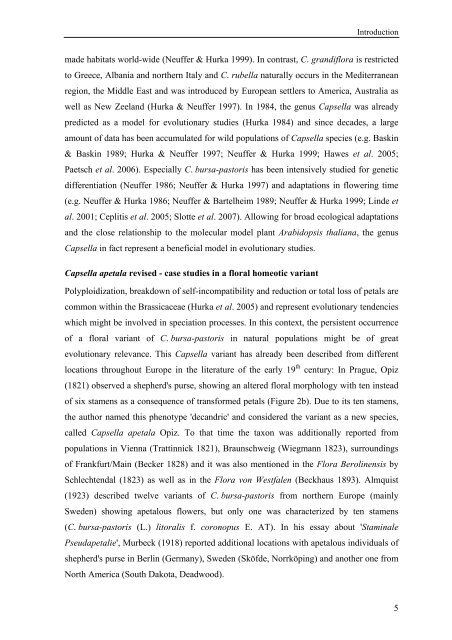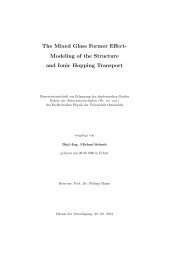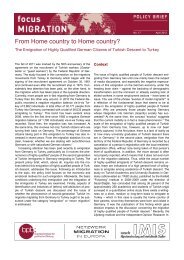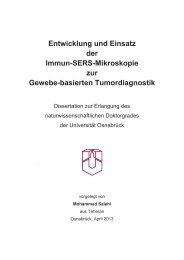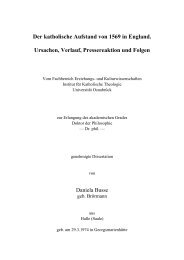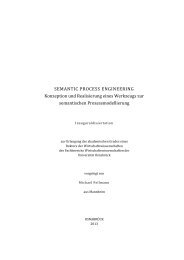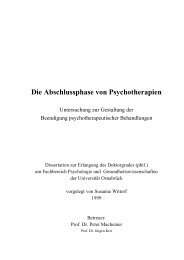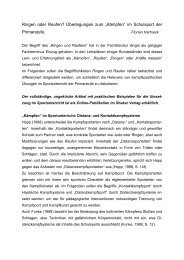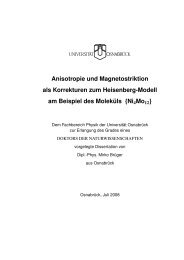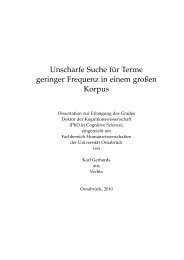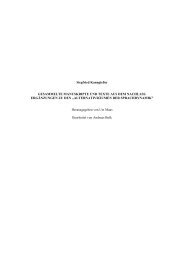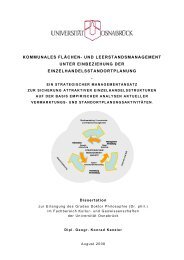'STAMENOID PETALS' IN A NATURAL HOMEOTIC VARIANT OF
'STAMENOID PETALS' IN A NATURAL HOMEOTIC VARIANT OF
'STAMENOID PETALS' IN A NATURAL HOMEOTIC VARIANT OF
You also want an ePaper? Increase the reach of your titles
YUMPU automatically turns print PDFs into web optimized ePapers that Google loves.
Introduction<br />
made habitats world-wide (Neuffer & Hurka 1999). In contrast, C. grandiflora is restricted<br />
to Greece, Albania and northern Italy and C. rubella naturally occurs in the Mediterranean<br />
region, the Middle East and was introduced by European settlers to America, Australia as<br />
well as New Zeeland (Hurka & Neuffer 1997). In 1984, the genus Capsella was already<br />
predicted as a model for evolutionary studies (Hurka 1984) and since decades, a large<br />
amount of data has been accumulated for wild populations of Capsella species (e.g. Baskin<br />
& Baskin 1989; Hurka & Neuffer 1997; Neuffer & Hurka 1999; Hawes et al. 2005;<br />
Paetsch et al. 2006). Especially C. bursa-pastoris has been intensively studied for genetic<br />
differentiation (Neuffer 1986; Neuffer & Hurka 1997) and adaptations in flowering time<br />
(e.g. Neuffer & Hurka 1986; Neuffer & Bartelheim 1989; Neuffer & Hurka 1999; Linde et<br />
al. 2001; Ceplitis et al. 2005; Slotte et al. 2007). Allowing for broad ecological adaptations<br />
and the close relationship to the molecular model plant Arabidopsis thaliana, the genus<br />
Capsella in fact represent a beneficial model in evolutionary studies.<br />
Capsella apetala revised - case studies in a floral homeotic variant<br />
Polyploidization, breakdown of self-incompatibility and reduction or total loss of petals are<br />
common within the Brassicaceae (Hurka et al. 2005) and represent evolutionary tendencies<br />
which might be involved in speciation processes. In this context, the persistent occurrence<br />
of a floral variant of C. bursa-pastoris in natural populations might be of great<br />
evolutionary relevance. This Capsella variant has already been described from different<br />
locations throughout Europe in the literature of the early 19 th century: In Prague, Opiz<br />
(1821) observed a shepherd's purse, showing an altered floral morphology with ten instead<br />
of six stamens as a consequence of transformed petals (Figure 2b). Due to its ten stamens,<br />
the author named this phenotype 'decandric' and considered the variant as a new species,<br />
called Capsella apetala Opiz. To that time the taxon was additionally reported from<br />
populations in Vienna (Trattinnick 1821), Braunschweig (Wiegmann 1823), surroundings<br />
of Frankfurt/Main (Becker 1828) and it was also mentioned in the Flora Berolinensis by<br />
Schlechtendal (1823) as well as in the Flora von Westfalen (Beckhaus 1893). Almquist<br />
(1923) described twelve variants of C. bursa-pastoris from northern Europe (mainly<br />
Sweden) showing apetalous flowers, but only one was characterized by ten stamens<br />
(C. bursa-pastoris (L.) litoralis f. coronopus E. AT). In his essay about 'Staminale<br />
Pseudapetalie', Murbeck (1918) reported additional locations with apetalous individuals of<br />
shepherd's purse in Berlin (Germany), Sweden (Sköfde, Norrköping) and another one from<br />
North America (South Dakota, Deadwood).<br />
5


